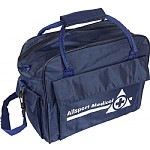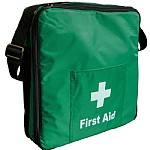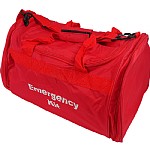
First aid bags are portable means of storing your first aid kit, ideal if you are looking for a way of taking supplies with you when travelling, hiking and during emergency situations. The larger bags are a favourite for emergency services as it allows them to carry supplies quickly to the scene of an accident.
Having first aid supplies in case of an emergency is a legal requirement for schools and workplaces, but also provides peace of mind when travelling or at home. These first aid kits can be purchased fully stocked or can be created yourself using a first aid kit and supplies that are specific to the activity they will be providing support for.
In this article we will discuss the most important items to be included in a first aid kit, questions that we regularly receive about our first aid bags and how travelling and airport considerations can affect what supplies you are carrying.
What are the 10 most important items in a first aid kit?
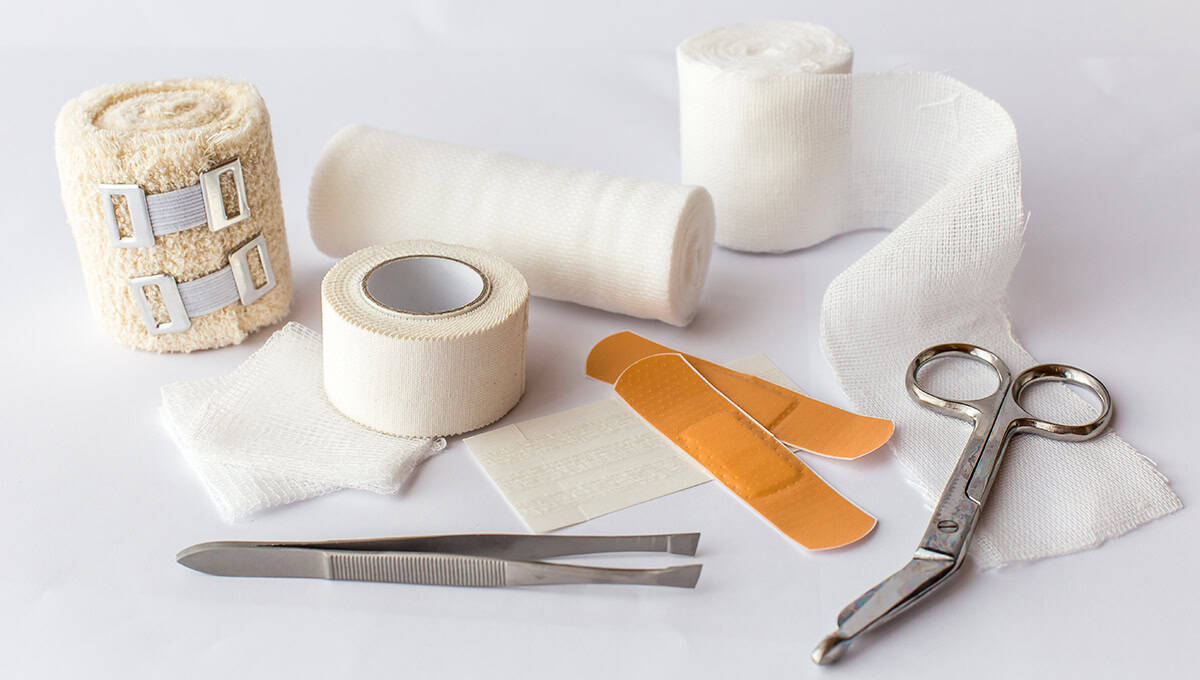
While the contents of a first aid kit may vary, certain supplies are required in all kits to comply with HSE regulations. This is why most schools and workplaces, at a minimum, maintain an HSE-compliant or British Standard first aid kit as a foundation, upon which additional supplies may be added.
Here’s a checklist of 10 of the most important supplies to include in your first aid kit:
- Plasters - it will depend on your needs as to which type of plaster is included in the kit, but every first aid kit (no matter what it is for) needs plasters.
- A first aid guidance leaflet - Designed to assist individuals without formal training by providing clear instructions on how to administer basic first aid for common situations.
- Wound dressings - Similar to plasters, the type of dressings will differ depending on the type of first aid kit being created, for example trauma dressings wouldn’t be in an everyday first aid kit. However, dressings come in very handy when covering a wound and are found in all of our first aid kits.
- General bandages - Having bandages in your first aid kit provides you with the means to hold dressings in place and add further support or pressure to a wound.
- Triangular bandages - Triangular bandages can be used for both wound care and supporting an injury, most commonly they are used to stabilise a suspected broken bone.
- Eye dressings - These are ideal for covering the eye after injury to protect it from further harm once the eye has been rinsed out.
- Wipes - Sterile wipes are used in wound cleansing to prevent contamination and infection. They can also be used to clean hands before treating wounds if no fresh water or gloves are available.
- Gloves - Following on from the wipes, another important item to include in a first aid kit is a pair of gloves. Having gloves available will limit cross contamination when a casualty is being treated, both to the wound and the first aider.
- Safety pins - Perfect for holding dressings and bandages in place when needed, the safety pins make a great addition to any supply kit.
- Face shield - Provides a protective barrier during CPR, helping to reduce the risk of transmitting infections between the first aider and the casualty during rescue breaths.
What should not be included in a first aid kit?
Just as different types of first aid kits have some overlap in what they should contain, there are also common elements that shouldn’t be included:- Medication – In workplace first aid kits, or those that are being used by multiple people, medication should not be included. This is because there is a risk of allergic reaction or someone taking a tablet that will react badly with their prescribed medication.
- Needles – When carrying a needle in public it should only be for medical needs, such as diabetes, and stored/disposed of correctly. These should not be included in first aid kits as they are for personal use and should only be used by those who know how to do so.
- Scalpels – Anything sharp should be kept out of first aid kits, particularly if they are being used as travel kits and you are hoping to pass through airport security with them. This is because scalpels should only be used by medical professionals in first aid situations.
- Excess first aid supplies – While it might seem helpful to include multiples of certain items, overstocking your kit with unnecessary supplies can take up valuable space, potentially crowding out essential items. Additionally, surplus items are unlikely to be used before their expiry date.
- Out-of-date supplies – Expired supplies occupy space that could be used for effective emergency equipment and can also pose a risk, particularly if expired medications or compromised materials are involved.
Should I include medication like paracetamol or ibuprofen in my first aid bag?
Medication should only be included in a first aid bag if the bag is for personal use.As a general rule, medicine should not be stored in a first aid kit, especially if multiple people are using it, for example a workplace first aid kit. This is because some people may have allergies, intolerances, or already be taking prescription medication that could react poorly with the ones within the kit. This is why pre-assembled first aid kits do not include medications such as paracetamol or ibuprofen.
Medication should be stored according to the instructions and kept out of reach of children, but somewhere that it is easily accessible.
Should you have an EpiPen in your first aid kit?
An EpiPen should not be included in your first aid kit. EpiPen’s are only used if prescribed and by those who have been trained to use them, particularly in work and school settings.Since EpiPens are prescribed for individual use, the person should keep it close at hand, often in a bag or at their workstation, ensuring it is easily accessible and can be administered without delay.
In a school or workplace, while it is not advisable to keep an EpiPen in the first aid kit, it is important to have a designated individual responsible for taking the lead if it needs to be used and an open line of communication so that all staff are aware of what should happen in an emergency.
What items have expiry dates?
All sterile items in a first aid kit will have expiry dates, while those that don’t will be up to personal judgement on whether they are safe to use. Using supplies when they are out of date can cause them to be less effective. For example:- The adhesive will lose grip on products such as plasters and adhesive dressings.
- If sterile items such as dressings or wipes are used once they have expired, it can cause an infection.
- If a normally sterile item like a plaster, wipe or dressing has damaged packaging it could have become compromised by contaminants leading to a higher chance of infection.
The benefits of creating your own portable first aid kit
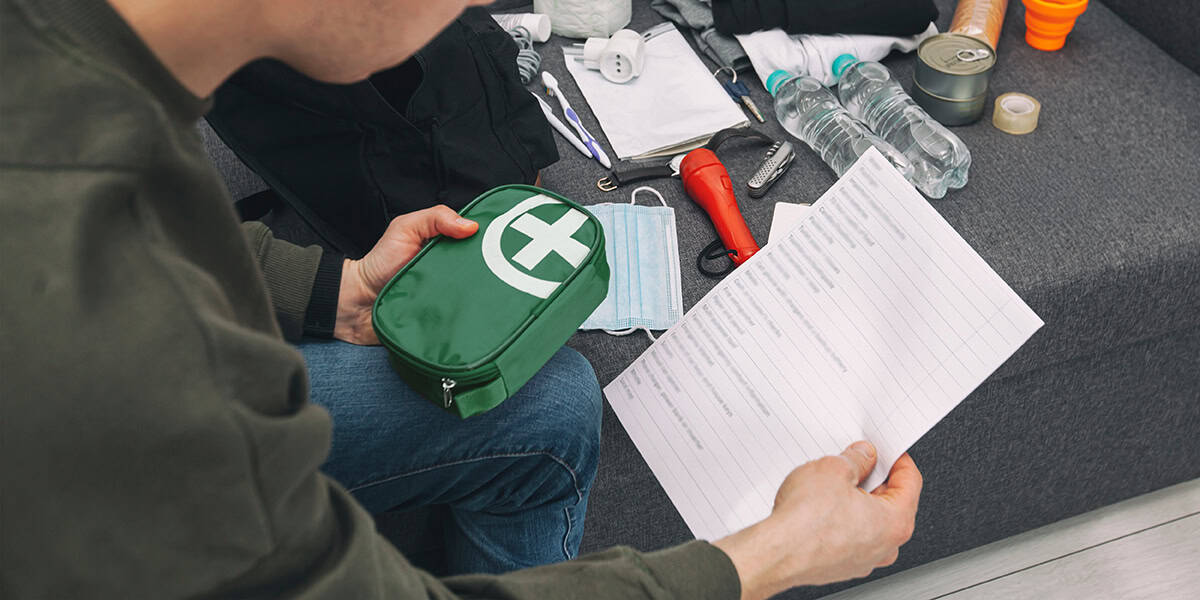
Creating your own bespoke portable first aid kit using an empty bag or case will allow you to include any supplies you believe to be a necessity as well as ensure that the sizes are all appropriate to your needs. For example, you will be able to add a higher volume of small gloves instead of a standard medium or large, if needed to better suit the size of your hands.
Other benefits include:
- Being able to adjust the supplies depending on the activity
- Creating personalised kits based on legal restraints when travelling
- Removing products that may contain an allergen such as latex if a member of your family is allergic
- Ensuring the case will fit into the space you have available
For travel in the UK
If you are travelling in the UK, you will largely be able to predict the kind of supplies that will be necessary depending on the activities you are completing. Having supplies suitable for road trips and general travel first aid will help to ensure that you are fully covered on your journey.For travel abroad
Creating your own first aid kit for travelling abroad will allow you to adjust the contents depending on your destination to ensure that you are legally compliant with the laws of the country you are visiting and airport security. Government websites advise individuals to always check with the embassy of the country that you are visiting before traveling to ensure you aren’t carrying anything that will cause issues when arriving in customs.For home
Accidents and emergencies can happen anywhere, including the safety of our own homes. This is why having a fully stocked, portable home first aid kit is essential, as you can pick it up and go anywhere in the house or have it packed during an evacuation. When building your home first aid kit, think about the contents and specifically what would work best for your family.What is a portable first aid bag?
A portable first aid bag is one of the many ways to store a first aid kit. This type of storage allows essential supplies to be easily transported to wherever an emergency occurs, ensuring help is readily available when and where it's needed.First aid bags come in a variety of shapes, sizes and colours to suit all medical needs. The majority of first aid bags will come in the standard green, however our Emergency Trauma Kit is a large red bag while our Football and Rugby First Aid Kit is in a large blue bag.
Shoulder bags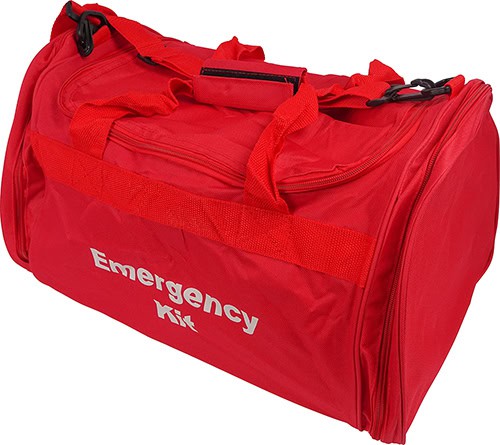
Shoulder bags for first aid kits tend to be larger than other portable first aid bags as they are generally used for convenience during sporting matches or emergency evacuations.
This type of portable first aid bag is also the preference of emergency services as they tend to provide more space and different compartments for the first aid supplies, allowing for quick and easy retrieval when time is of the essence.
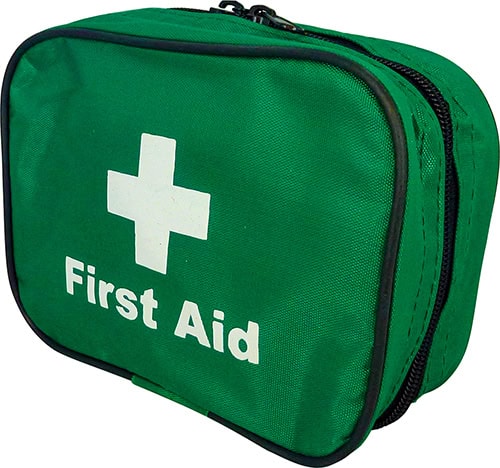 Bum bags & belt pouches
Bum bags & belt pouches
In some situations, it can be ideal to have a small first aid kit that can be attached to your belt or tied around your waist. For example, a teacher on playground duty would be able to carry a small amount of first aid supplies to provide immediate help to a child who has suffered from minor injuries outside without needing to send for additional support.
Creating a first aid kit in a bum bag or belt pouch ensures that even when you’re on the move and have limited space in your luggage, you will always have easy access to first aid supplies.
Rucksacks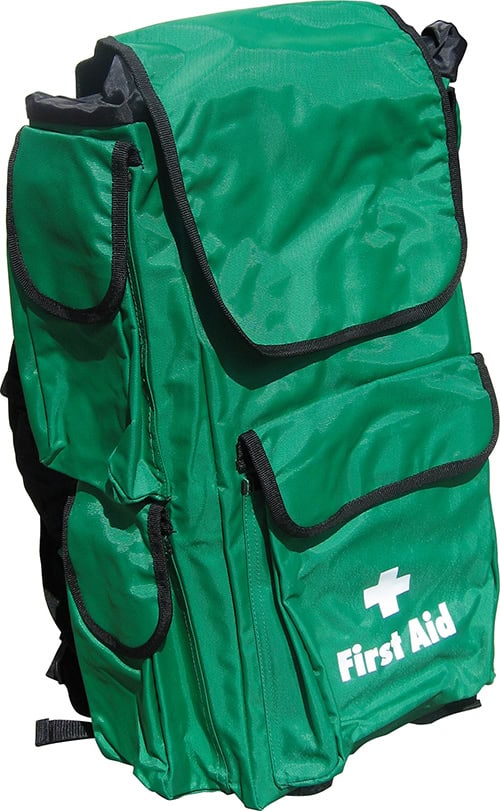
Having a rucksack filled with first aid supplies is ideal for when you are participating in activities that require use of both hands as well as needing a more comprehensive first aid supply than you would achieve with a bum bag.
First aid rucksacks provide ample space for the supplies including separate compartments to store smaller items that might get lost in the main bag. They also tend to have adjustable straps so if you are in a group that likes to share the load, you will be able to pass the rucksack around and quickly adjust it to be comfortable and fit almost all body types.
Water-resistant first aid bags
If you are looking for a portable first aid bag that is suitable for outside activities, having one that is water-resistant is perfect, particularly if you are planning on using it in the UK or a climate that is liable to change at a second’s notice.Portable first aid bags vs. cases and cabinets
With the many different ways to store first aid available today, choosing the option that works best for you can be challenging.Whether you decide to choose a first aid bag, case or cabinet will largely depend on your needs. For example, if you required a kit that would be travelling around with you, a first aid cabinet would automatically be ruled out as it is too cumbersome to transport.
Comparing first aid bags to cases comes down to how flexible you want the outside of the case to be. A lot of the first aid bags are made of nylon fabric which means they can be squashed when needed and will take on other shapes if not filled to the brim, whereas first aid cases tend to be rigid plastic, not easily conforming to their storage locations.
First aid bags also tend to be designed with portability in mind. They will have padded straps or loops making it easier to carry for longer, some allowing you to still use both hands while carrying them. In contrast, the majority of first aid cases have handles made of plastic and while they are great for transporting the kits to the scene of an emergency, they aren’t designed to be held for long periods of time.
Bags vs wall-mounted cabinets
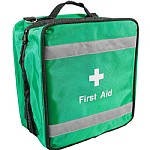
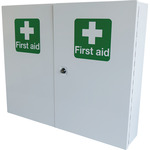
Bags:
Portable
Holds necessary medical supplies
Easily identifiable
Adjustable for specific needs
Perfect for travel first aid
Portable
Holds necessary medical supplies
Easily identifiable
Adjustable for specific needs
Perfect for travel first aid
Cabinets:
Wall-mountable
Holds wide range of supplies
Ideal for first aid rooms
Easily identifiable
Wall-mountable
Holds wide range of supplies
Ideal for first aid rooms
Easily identifiable
Uses and legal compliance of first aid bags
In many locations, especially those with a high daily footfall, such as workplaces, schools, or entertainment venues, there are legal requirements that must be met regarding first aid provisions.Most workplaces and schools, for example, require at least one member of staff to be first aid trained so that they can take lead in an emergency and have the “adequate and appropriate” supplies for their needs.
First aid bags are used for a variety of different activities as they are easy to store and transport, commonly used by schools, emergency services and holiday makers in particular. By having a first aid kit that moves with you, it allows businesses such as schools to always remain compliant with legal requirements and be able to provide immediate medical attention regardless of where the accident took place.
Schools
Schools in particular will have strict protocols that should be followed in situations that require first aid, with rules about accident reporting, how many first aiders should be present both on-site and at external events and what should be included in the first aid kits. These protocols will extend beyond the premises when students are taken on school trips, which is when it comes in handy to have a portable school first aid kit.First aid requirements in schools are very similar to those created for workplaces, however they will have multiple bodies ensuring that they are followed such as Ofsted, not just the HSE.
Workplaces
All workplaces are required by law to have "adequate and appropriate" first aid supplies to hand for any potential hazards on the premises. Having a first aid bag will not only ensure that emergency medical care can be provided in that location, but that in the case of an accident happening further away or an emergency evacuation it can be taken with workers.First aid bags such as bum bags and our personal trauma kits are especially popular with lone workers and those that are on the go or working outside. This is because they are compact, can be attached to the waist and will provide access to first aid regardless of where they are.
Holiday lets
If you are staying at a holiday let, it is the owner’s responsibility to ensure that health and safety requirements are met, that a risk assessment has been completed and measures are in place to limit the risks. As a result, it is best practice for the owners of holiday lets to provide first aid kits for those staying in their accommodation.These first aid kits are usually in small cases that will fit into drawers or other easily accessible areas, but some owners may choose to supply a cabinet or first aid point to cover a variety of circumstances and provide a centralised, comprehensive collection of first aid supplies.
Travellers
When travelling, regardless of the mode of transport, having a first aid kit on hand is essential.Commercial vehicles in particular have regulations that need to be followed to ensure a safe journey for all. For example, HGVs must carry a fire extinguisher with them at all times, which is something that, unless you are buying both the first aid kit and fire extinguisher at the same time, will need to be added to standard kits.
Furthermore, when driving abroad on your travels, different countries will have different legal requirements. For example, some European countries, such as France and Italy, require drivers to have a specific number of hi vis jackets and one or more safety triangles. These tend not to be included in pre-made first aid kits, so will either need to be added to an existing one or included when creating your own.
Hikers/backpackers
It is essential to have a first aid kit readily accessible at all times while going on long walks or backpacking breaks. Although hikers and backpackers aim to keep their loads as light as possible, carrying sufficient supplies to provide adequate coverage in emergencies is crucial. This is especially important when navigating difficult terrain, where emergency services may take longer to reach your group if they are needed.Travel & airport considerations
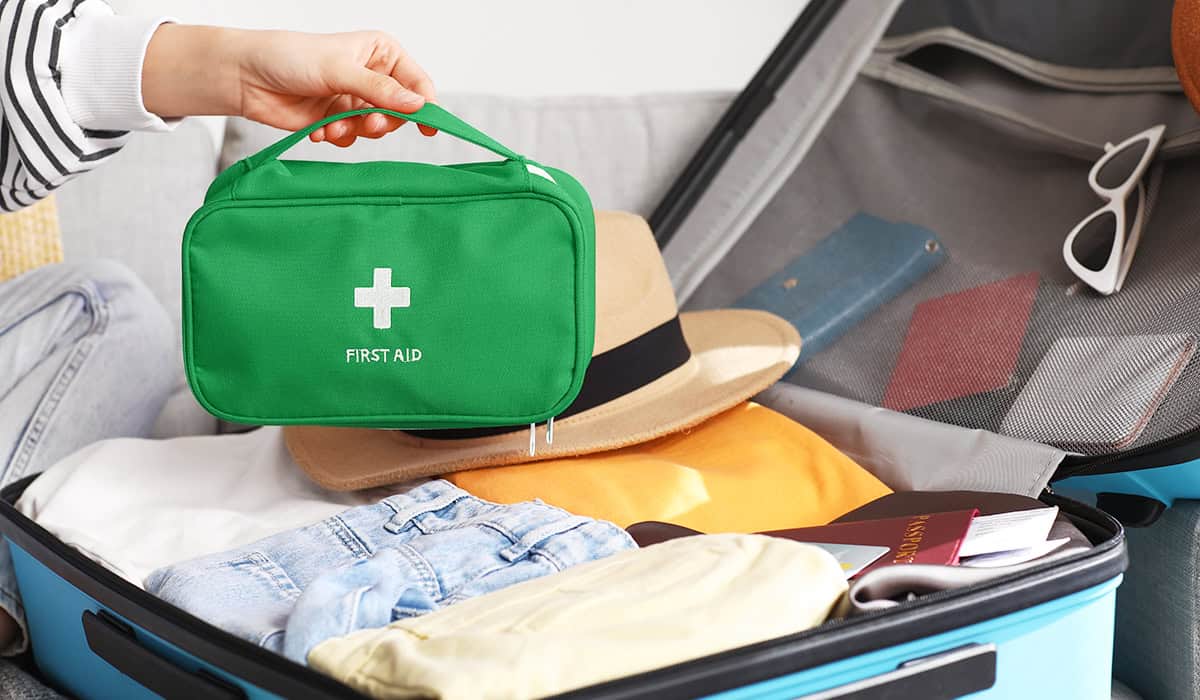
When travelling with first aid kits, it’s important to be prepared for emergencies, especially regarding medications. Different countries have varying regulations, and airport security can be challenging. For example, Turkey and UAE have a very strict list of what can be bought into the country. However, careful planning and understanding what to expect can help ensure you are fully prepared, particularly when travelling by air.
Can I take a first aid kit on a plane in the UK?
Yes, you can take a first aid kit onto a plane in the UK; however, there are restrictions if it is being transported in your hand luggage. For example, the blades of the scissors have to be under four inches and all liquids, creams, etc (unless prescribed) must be included in your liquid allowance.Do pills have to be in original bottles when flying?
To start with, if your medication is a controlled substance, you will need to check that it is allowed in the country you are flying to, either by the embassy or their government website. Some countries may even require you to have a personal license to use certain pills while visiting.It is advised that you keep any tablets/pills in the original packaging when flying, however for most countries it is not mandatory. Some locations, such as Greece insist that pills, especially those that have been prescribed to you be in the original packaging with the prescription label, while others will allow you to travel using pill organisers.
Do inhalers need to go in a liquid bag?
As liquid restrictions do not apply to prescription medication, inhalers do not need to go into a liquid bag when travelling through airport security. You will need to bring either a repeat prescription or doctor’s note with you to prove that it is prescribed medication and that you are the person that it is intended for, similar to what you would expect when travelling with insulin.How do I pack medication for a holiday?
- Pack it into your hand luggage wherever possible – this ensures that it won’t get lost or damaged in transit.
- Ensure you have enough to last the whole trip.
- Check that it is legal in the country you are travelling to.
- Ideally, keep it in the original packaging.
- Keep a copy of your prescription or have a doctor’s note.
Conclusion
Building your own first aid kit using an empty first aid bag is an ideal way to ensure that you will have a portable kit with all the supplies required for your specific needs. It is ideal when travelling, particularly hiking or by plane with only hand luggage, as you can create a kit with minimal liquids that is compact and lightweight.Understanding what you need from your first aid kit, and the potential risks you may encounter on your excursion, will help determine how supplies should be stored, and which items should be included. Since these needs can vary depending on the purpose of the kit, versatility is key when assembling a personal first aid kit.
Browse our range of empty first aid bags to build a custom kit that suits your exact needs.
Read our other blogs for more information on first aid or contact us for further advice and information on our products.
By Sarah Mason
Explore more:


